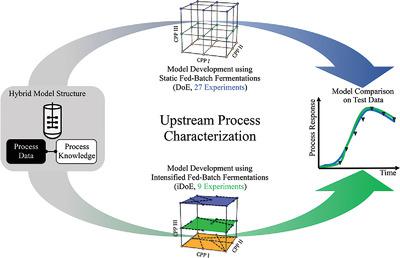当前位置:
X-MOL 学术
›
Biotechnol. J.
›
论文详情
Our official English website, www.x-mol.net, welcomes your feedback! (Note: you will need to create a separate account there.)
Hybrid Modeling and Intensified DoE: An Approach to Accelerate Upstream Process Characterization.
Biotechnology Journal ( IF 4.7 ) Pub Date : 2020-06-05 , DOI: 10.1002/biot.202000121 Benjamin Bayer 1 , Gerald Striedner 1 , Mark Duerkop 1, 2
Biotechnology Journal ( IF 4.7 ) Pub Date : 2020-06-05 , DOI: 10.1002/biot.202000121 Benjamin Bayer 1 , Gerald Striedner 1 , Mark Duerkop 1, 2
Affiliation

|
Process characterization is necessary in the biopharmaceutical industry, leading to concepts such as design of experiments (DoE) in combination with process modeling. However, these methods still have shortcomings, including large numbers of required experiments. The concept of intensified design of experiments (iDoE) is proposed, that is, intra‐experimental shifts of critical process parameters (CPP) that combine with hybrid modeling to more rapidly screen a particular design space. To demonstrate these advantages, a comprehensive experimental design of Escherichia coli (E. coli) fed‐batch cultivations (20 L) producing recombinant human superoxide dismutase is presented. The accuracy of hybrid models trained on iDoE and on a fractional‐factorial design is evaluated, without intra‐experimental shifts, to simultaneously predict the biomass concentration and product titer of the full‐factorial design. The hybrid model trained on data from the iDoE describes the biomass and product at each time point for the full‐factorial design with high and adequate accuracy. The fractional‐factorial hybrid model demonstrates inferior accuracy and precision compared to the intensified approach. Moreover, the intensified hybrid model only required one‐third of the data for model training compared to the full‐factorial description, resulting in a reduced experimental effort of >66%. Thus, this combinatorial approach has the potential to accelerate bioprocess characterization.
中文翻译:

混合建模和强化DOE:一种加速上游过程表征的方法。
在生物制药行业中,过程表征是必不可少的,它导致诸如实验设计(DoE)与过程建模相结合的概念。但是,这些方法仍然存在缺点,包括大量必需的实验。提出了强化实验设计(iDoE)的概念,即关键过程参数(CPP)的实验内转移与混合建模相结合,可以更快地筛选特定的设计空间。为了证明这些优点,对大肠杆菌(E. coli)进行了全面的实验设计介绍了产生重组人超氧化物歧化酶的补料分批培养(20 L)。在不进行实验内变动的情况下,评估了在iDoE和部分因子设计下训练的混合模型的准确性,以同时预测全因子设计的生物质浓度和产品效价。经过iDoE数据训练的混合模型描述了全时间设计中每个时间点的生物质和产品,具有很高的准确性。与强化方法相比,分数阶因子混合模型显示出较差的精度和精确度。此外,与全要素描述相比,强化混合模型仅需要模型训练数据的三分之一,从而将实验工作量减少了> 66%。从而,
更新日期:2020-06-05
中文翻译:

混合建模和强化DOE:一种加速上游过程表征的方法。
在生物制药行业中,过程表征是必不可少的,它导致诸如实验设计(DoE)与过程建模相结合的概念。但是,这些方法仍然存在缺点,包括大量必需的实验。提出了强化实验设计(iDoE)的概念,即关键过程参数(CPP)的实验内转移与混合建模相结合,可以更快地筛选特定的设计空间。为了证明这些优点,对大肠杆菌(E. coli)进行了全面的实验设计介绍了产生重组人超氧化物歧化酶的补料分批培养(20 L)。在不进行实验内变动的情况下,评估了在iDoE和部分因子设计下训练的混合模型的准确性,以同时预测全因子设计的生物质浓度和产品效价。经过iDoE数据训练的混合模型描述了全时间设计中每个时间点的生物质和产品,具有很高的准确性。与强化方法相比,分数阶因子混合模型显示出较差的精度和精确度。此外,与全要素描述相比,强化混合模型仅需要模型训练数据的三分之一,从而将实验工作量减少了> 66%。从而,


























 京公网安备 11010802027423号
京公网安备 11010802027423号